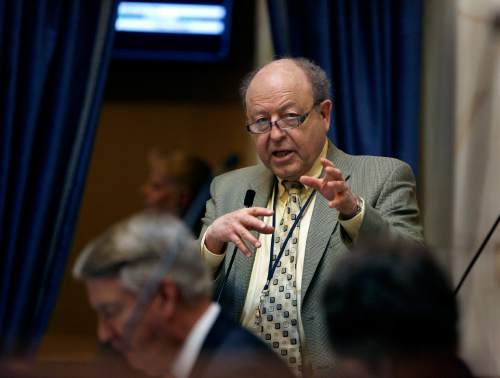This is an archived article that was published on sltrib.com in 2015, and information in the article may be outdated. It is provided only for personal research purposes and may not be reprinted.
State taxpayers could end up spending $1.5 million next year to help Utah State University compete for the best recruits for its football, basketball and other sports teams.
Senate Budget Chairman Lyle Hillyard, R-Logan, says other universities that compete with Utah State are promising stipends to student-athletes — beyond the tuition and housing covered in their scholarships — and the Aggies need to be able to do the same to compete for recruits.
"I can tell you if an 18-year-old comes in, the first question they'll ask is, 'Are you going to provide the full cost of attending?'" said Ken White, USU's NCAA faculty athletic representative and dean of the College of Agriculture. "And if we have to say no, they'll probably fall off the table" and go to another school.
Hillyard couched the program as an economic-development program: When the Aggie football team is competitive, the stadium is full and fans fill hotels and restaurants on game weekends.r
The NCAA changed its policy last August, allowing 65 schools from the power conferences — the ACC, Big 10, Big 12, Pac 12, and SEC — plus Notre Dame, to begin paying athletes stipends of a few thousand dollars for things like meals, clothing and some incidental expenses.
Other schools are following suit, including schools in the Mountain West Conference, where USU plays.
Sen. Ann Millner, R-Ogden, the former president of Weber State University, questioned the fairness of taxpayers helping athletes at one school in the state.
"So the [USU] students will have an opportunity to get stipend money that other students across the state won't have?" she asked.
But with Utah State on the cusp of being nationally competitive and vying for recruits with the other conferences and teams that pay the stipends, argue Aggie boosters, the teams need to be able to make the payments to stay relevant.
"The Mountain West is really on the verge or edge," Hillyard said. "If we don't compete, if we don't have the athletes, we won't have the shot to get into the special [college football] bowl games like Boise State did."
The University of Utah will begin paying the costs of attendance for student-athletes in the 2015-16 school year, according to Liz Abel, associate athletics director at the U. It is expected to cost about $1 million and the school is currently raising money from boosters and private sources.
Because of federal requirements that women's college athletics have to have a level playing field with men's, the stipends would extend to several women's programs, as well.
Members of the Legislature's Business, Economic Development and Labor Committee will decide whether the USU athletic stipends are a funding priority, but Hillyard, as the Senate budget chairman, will be involved in the final budget negotiations as the end of the session nears.



